The 12 Best Day Trips From Madrid
If you have time do consider a visit to Real Casa de la Moneda, Spain’s former royal mint.
15 Best Day Trips from Madrid
Our travel recommendations are based on our personal experiences and research, written by locals and travel experts with deep familiarity with the destination. When you book a hotel or tour that we link to, we may earn a commission.
Madrid is one of the most popular cities in all of Europe. Partly due to their world famous football team, Real Madrid, and in part for the incredible history and architecture that it houses, Madrid really does have something for everyone.
With balmy summer days and cool winter months Madrid is a year-round destination and each season brings something new to explore.
Once you have ticked off the Buen Retiro Park, the Royal Palace and of course the Plaza Mayor, it’s time to escape the city limits and explore Spain as a whole.
From historic cities to wine regions, from royal palaces to coastal retreats there is a heap of great day trips from Madrid to enjoy.
Let’s take a look:
1. Barcelona

Although a fair hike, Barcelona can be easily reached in the space of a day trip from Madrid.
Spain’s buzzing second city has a whole host of cultural and historical gems to explore.
The Sagrada Família and Park Güell are the must-visit sights in Barcelona.
Park Güell is one of the most famous landmarks in all of Spain and is a one of Gaudi’s most impressive architectural works.
Football fans will have ample time to sign up to a tour of Camp Nou, the stadium home ground for FC Barcelona.
Self-confessed foodie travellers should make a beeline for La Boqueria, Barcelona’s famous indoor food market.
2. Toledo

Toledo is one of Spain’s best loved UNESCO World Heritage Sites and is a great addition to any visit to this wonderful nation.
Toledo is often dubbed at the ‘City of Three Cultures’ for it has been home to harmonious communities of Christians, Jews and Muslims for decades.
Toledo provides a wonderful introduction to all three faiths and the religious buildings that are scattered throughout the city are each more magnificent than the last.
Toledo is situated atop of a gorge that offers incredible views over the Río Tajo.
Home to a wonderful history of art, Toledo provided an artistic sanctuary for greats like El Greco.
3. Segovia

A highlight of any day trip to Segovia is to marvel at the Aqueduct of Segovia.
That said, the Alcázar of Segovia is pretty darn impressive, as is the Royal Palace of La Granja de San Ildefonso.
The Aqueduct of Segovia was built by the Romans, features two tires and a whopping 167 arches.
It’s a awe-inspiring feat of historic construction that has stood the test of time.
The Alcázar of Segovia is certainly not to be missed.
This restored medieval castle has been brought back to life after a devastating fire.
The rooms are beautiful decorated and the armoury museum is seriously impressive.
If you have time do consider a visit to Real Casa de la Moneda, Spain’s former royal mint.
4. Avila

Avila is a historic walled city that lies just over 100 km from Madrid.
Known also at the Town of Stones and Saints, Avila has an interesting history to explore.
It really is incredible that the walls and turrets of Avila are still standing.
The town features over 80 of these towers and there nine different gated entrances.
Despite its age it is still possible to walk along the top some sections of the walls which is a wonderful experience, offering amazing views of the town below.
Within the walls of Avila you will find a fortified cathedral that dates back to the 12th-Century and a number of gothic palaces which are not to be missed.
5. Salamanca

Salamanca is another Spanish city to be listed as a UNESCO World Heritage Site and deservingly so, there is just so much culture and history here.
The New Cathedral of Salamanca is truly a sight to behold.
Ornate and imposing, the Cathedral features unique carvings that have been added slowly throughout the years, including an astronaut (of all things) during the 1990s.
For those interested in gothic architecture Casa de las Conchas should not be overlooked.
Covered from top to bottom in seashell motifs the Casa de las Concha one of Salamanca’s hidden gems.
6. Madrid’s Wine Country

Madrid is not only a city but the name for the whole region of Spain.
This region sees Manzanares, Tajuña, Jarama, Henares and Tajo rivers come to confluence.
All this water makes the landscape incredibly fertile, add in the Spanish sunshine and you have the perfect recipe for a vineyard.
There are dozens of wineries in the Madrid wine country and the winemaking history of this area dates back nearly a century.
During a day trip to the wine region you not only have the opportunity to taste some of Europe’s best wines but to learn about grape cultivation, wine production and the history of this lush landscape too.
This area is particularly famous for its Tempranillo grapes.
7. Las Rozas Village

Las Rozas Village is the leading outlet shopping facility in Madrid Region.
Lying just 30-minutes from Madrid city centre, Las Rozas Village is home to over 100 boutique stores offering up to 60% off luxury brand names.
If shopping is in order during your trip to Spain make sure to save yourself for Las Rozas Village.
With shops catering for men, women and children there is something for everyone.
There are a number of high end restaurants at Las Rozas Village that provide a welcome respite from a busy day bagging up bargains.
There is a Shopping Express coach that shuttles shoppers from central Madrid to the outlet and back again throughout the day.
8. Ribera del Duero

Spain produces some of the most highly sought after wines in the world and many of those wines are produced Ribera del Duero.
The landscapes of Ribera del Duero are simply breathtaking and couple this with the opportunity to sample some of the best wines in the world and you’re onto a real winner.
Ribera del Duero region is too home to an awesome selection of restaurants serving traditional Castilian food.
If you’re seeking a food based cultural adventure then a day trip to the Ribera del Duero region is certainly for you.
9. San Lorenzo de El Escorial

The small down of San Lorenzo de El Escorial is home of the royal seat.
In centuries gone by San Lorenzo de El Escorial was the full time residence for the King of Spain.
El Escorial itself in an vast imposing building build during the Renaissance era and is an expansive palace complex that could take a whole day of its own to explore.
If you’re travelling with children you can add a little variety into the mix and take a few hours to visit the Insect Park; an easy way to get the little ones back onside during a history filled day.
10. La Mancha

La Mancha is a region of central Spain, east of Madrid, that provided the setting for ‘Don Quixote’ the 17th-Century novel by Miguel de Cervantes.
A visit to La Mancha region offers you the opportunity to walk in the footsteps of the lovable nobleman and connect with the Spanish countryside.
La Mancha is home to the largest vineyard in the world.
Budding sommeliers will not miss the chance to visit such a significant spot.
The wineries of La Mancha still employ traditional winemaking methods Easily one of the most beautiful areas of Spain La Mancha is best experienced with a glass of wine in one hand and a copy of ‘Don Quixote’ in the other.
11. Cordoba

There is just so much to explore in Cordoba, for lovers of architecture it is not to be missed.
Set in Andalusia, Cordoba has a rich and vibrant history.
The Mosque of Cordoba is constructed in typical Moorish style and features an impressive basilica.
Considered to be one of the greatest Islamic buildings in the world, the mosque is a wonderful starting point.
Moving on to the Alcázar de los Reyes Cristianos and the Calahorra Tower, these too should feature high on the must-visit list for Cordoba.
There are a number of high end restaurants in Cordoba that serve exquisite traditional tapas.
12. Royal Palace of Aranjuez

The Royal Palace of Aranjuez is a wonderful day trip from Madrid that can be coupled with a visit to Toledo if you are short on time.
The grounds of the Royal Palace of Aranjuez are wonderfully kept and a joy to explore.
From the Prince’s Gardens to the Island, to the Parterre, there is a fascinating array of vegetation to be found within the grounds and plenty of different tree species too.
The throne room houses phenomenal royal artefacts that give fascinating insights into the lives and times of monarchs gone by.
The Museum of Royal Feluccas is an interesting addition to a day trip and features exhibits on the royal boats.
13. Cuenca

Cuenca is one of Spain’s best kept secrets.
Although a UNESCO World Heritage Site Cuenca is often overlooked by travellers in favour of Toledo and Salamanca.
Most definitely worth a day trip from Madrid Cuenca has so much to explore.
The Hanging Houses of Cuenca really have to be seen to be believed.
The Bridge of San Pablo plays a vital role in this city’s history and is not for faint hearted nor those with acrophobia.
The Devil’s Nose train takes you on a picturesque journey through the Andes is an option most definitely for travellers who opt for a cheeky overnight stay in Cuenca.
14. Pedraza

Pedraza is a medieval town that lies just 37 km from Segovia, to the north east.
It is a charming, rustic town that is rich in history and culture.
With cobbled streets and plenty of cafes serving up traditional tapas, Pedraza offers you the opportunity to get at one with the Spanish pace of life and experience the culture at its most authentic.
The Pedraza Castle is not to be missed and houses the masterpieces of Ignacio Zuloaga.
Pedraza is home to the annual Fiestas Patronales which sees bulls run through the winding streets and bull fighting in the Plaza Mayor.
15. Valencia
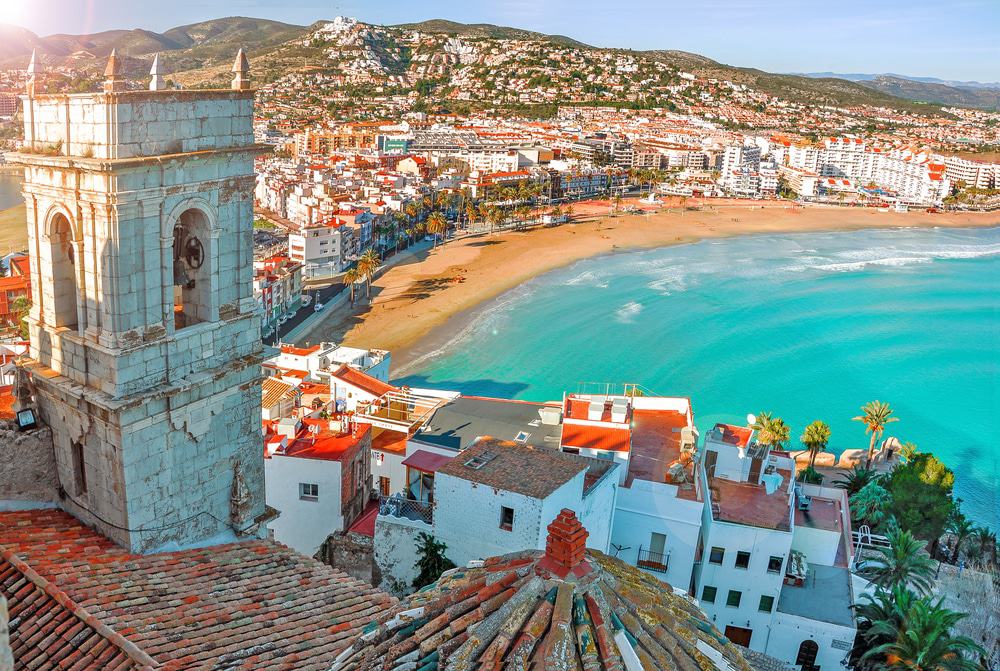
If a trip to the coast be the order of the day then a visit to Valencia is a great option.
Just an hour and a half from Madrid city centre is the charming city of Valencia.
Sitting on the shores of the Mediterranean Sea, Valencia has a laid back atmosphere that will make you never want to leave.
A city known for its art culture, make sure to find time to visit the L’Oceanografic if only to marvel at the wave-like architectural design.
The Institut Valencia d’Art Modern has a great selection on modern art pieces on display throughout the year and a great cafe too.
15 Best Day Trips from Madrid:
- Barcelona
- Toledo
- Segovia
- Avila
- Salamanca
- Madrid’s Wine Country
- Las Rozas Village
- Ribera del Duero
- San Lorenzo de El Escorial
- La Mancha
- Cordoba
- Royal Palace of Aranjuez
- Cuenca
- Pedraza
- Valencia
The 12 Best Day Trips From Madrid
Lindsey Zimmerman is a freelance writer and travel expert who has lived in southern Spain since 2015.
Madrid is a world within a city, offering a thriving cultural atmosphere, great shopping and sightseeing, and unforgettable food. It also boasts a convenient location right in the heart of Spain itself, which makes the city a perfect home base when it comes to exploring the rest of the country. Throw in Spain’s excellent network of intercity transportation (particularly the AVE high-speed train), and there’s really no excuse not to take one of these day trips from Madrid. Here’s where to go if you want to see a different side of this fascinating country and be back in Madrid in time for an evening tapas crawl.
Toledo: The City of Three Cultures
:max_bytes(150000):strip_icc()/daytripsfrommadridtoledo-46f4bfe32aed4e348b0b7d460e4c9cef.jpg)
As Spain’s former capital, it probably comes as no surprise that Toledo offers a long and storied history of its own. What makes the city particularly unique is its influence by each of the three major world religions. The winding streets of the old Jewish Quarter, awe-inspiring cathedral, and Spain’s most impressive mosque outside of Cordoba help make this fascinating city one of a kind.
Getting There: AVANT trains operated by Renfe leave Madrid frequently and get you to Toledo in about half an hour.
Travel Tip: Toledo is quite hilly, and its cobblestoned streets can complicate things even further. Wear comfortable shoes if you plan on doing a lot of walking.
Barcelona: Cosmopolitan Catalan Culture
:max_bytes(150000):strip_icc()/besttimetovisitBarcelonaskyline-5c8a13d746e0fb0001a0bf85.jpg)
As Spain’s second-largest city and a thriving hub of culture and history in its own right, Barcelona has made a name for itself as one of Europe’s most exciting destinations. From the unfinished masterpiece that is the Sagrada Familia church and the quaint Catalan charm of picturesque Gracia, to a diverse drinks and dining scene and dozens of fabulous beaches, you’re guaranteed to never be bored in the Catalan capital.
Getting There: Take the high-speed AVE train from Madrid (operated by Renfe, Spain’s national rail service) to get there in two and a half hours.
Travel Tip: With endless options of things to see and do, Barcelona deserves more than just a day. Consider spending more time in the city in order to fully appreciate all it has to offer.
Seville: Andalusian Passion and Flamenco Flair
:max_bytes(150000):strip_icc()/daytripsfrommadridseville-70684826005946e5b63e718553fd7ab1.jpg)
Andalusia, Spain’s southernmost region, is often what people imagine Spain to be: sultry and passionate, with a near-constant soundtrack of flamenco beats. Perhaps no place encapsulates that image more than the regional capital, Seville, a colorful and vibrant destination that looks like a postcard come to life. Take some time to explore the breathtaking cathedral and Alcazar, then head to Maria Luisa Park to row a boat along the lazy river in Plaza de España when you need a breather.
Getting There: Take the Renfe-operated AVE from Madrid, which lasts roughly two and a half hours.
Travel Tip: Due to its appearance on a recent season of Game of Thrones, Seville’s Alcazar has become more popular than ever. Book your tickets online in advance to avoid long queues.
Segovia: A Living Fairy Tale
:max_bytes(150000):strip_icc()/daytripsfrommadridsegovia-b93c8d99a03c4c93b2937f50b67d408e.jpg)
While the towering Roman aqueduct may be Segovia’s biggest claim to fame, don’t just come for the sake of checking it off your list. The storied medieval town is also home to an incredible cathedral and a castle (the Alcázar) said to have inspired that of Disney’s Sleeping Beauty.
Getting There: Getting to Segovia from Madrid couldn’t be easier. Take the AVE train to get there in under half an hour.
Travel Tip: Segovia is famous for its cochinillo asado (roast suckling pig). Don’t leave without trying this delectable delicacy at a traditional spot like Restaurante José María.
El Escorial: A World Fit for Royalty
:max_bytes(150000):strip_icc()/daytripsfrommadridelescorial-9f65ab516d4748469729233126e2a64f.jpg)
It’s hard to sum up El Escorial in just a few words. Is it a palace, a monastery, a church or a library? The answer is all of the above, as well as the most important monument from the Spanish Renaissance. Constructed in the 16th century under the orders of King Philip II, the sprawling complex is one of Spain’s most fascinating destinations.
Getting There: Madrid’s commuter train, the Cercanías, will get you to El Escorial in about an hour. Take the C3 line from Atocha or Nuevos Ministerios. Bus 664 or 661 from Moncloa also get you there in about the same amount of time.
Travel Tip: While the eponymous royal complex is obviously the big draw for most visitors to San Lorenzo de El Escorial, try and take some time to explore the rest of the charming town if you can.
Valle de los Caídos: A Controversial Monument
:max_bytes(150000):strip_icc()/daytripsfrommadridvalledeloscaidos-671dc40b04e748e6be1909b406284a0f.jpg)
View Map Address Carretera de Guadarrama/El Escorial , 28209 San Lorenzo de El Escorial , Madrid , Spain
Perhaps the most controversial inclusion on this list of day trips from Madrid, Valle de los Caídos (Valley of the Fallen) is a remnant from Spain’s fascist years under dictator Francisco Franco. The monument itself—an impressive stone cross and basilica—was built by prisoners of the Spanish Civil War, and today serves as Franco’s final resting place.
Getting There: There is no direct public transport from Madrid to the valley—you have to make a stop in San Lorenzo de El Escorial (see above for information on reaching the town from Madrid). From El Escorial, take bus 660 to Valle de los Caídos o Cruce Cuelgamuros. The trip lasts 20-30 minutes.
Travel Tip: Due to the required stop in San Lorenzo de El Escorial, many travelers choose to combine the two into a single day trip from Madrid.
Ávila: The Majestic Walled City
:max_bytes(150000):strip_icc()/daytripsfrommadridavila-6b4242cf99ed44a7854a309e653e8955.jpg)
Often overlooked in favor of nearby Segovia and Salamanca, the beautifully preserved historic town of Ávila gives the more popular destinations a run for their money. Its biggest is the impressive medieval city wall, but another main draw is the Convent of Santa Teresa, a magnificent religious structure built on the home where St. Teresa of Ávila was born.
Getting there: Media Distancia trains from Madrid take about an hour and a half.
Travel Tip: Kill two birds with one stone: stop in Ávila for a few hours on your way to Salamanca to experience two of the region’s most breathtaking cities in one day.
Consuegra: The Town of Don Quijote Fame
:max_bytes(150000):strip_icc()/daytripsfrommadridconsuegra-e4b20c60cc414c10aaaa7d828c4d1091.jpg)
Anyone who read Don Quijote in their high school Spanish class may remember how the titular character famously confused the giant windmills of Consuegra for monsters with flailing arms. While the massive white structures are certainly the town’s biggest draw, the Moorish castle should not be overlooked, either.
Getting There: Buses operated by Samar take 2 hours and 20 minutes to reach Consuegra from Madrid.
Travel Tip: Stock up on saffron while in Consuegra. It may be the world’s most expensive spice, but it’s one of the region’s specialties.
Cordoba: The Caliphate City
:max_bytes(150000):strip_icc()/Cordobastreet-5c6d8ce946e0fb0001ce29d9.jpg)
Hop on a train in Madrid and you can be standing beneath the arches of Cordoba’s Moorish-area Mezquita in two hours. The historic city is also home to a medieval Alcázar offering beautiful gardens and impressive views from its towers. If you have time, a trip out to the shimmering Muslim palace-city of Medina Azahara is well worth the effort as well.
Getting There: Take the AVE from Madrid to get to Cordoba in under two hours.
Travel Tip: If you get into town early enough and want to save 10 euros, entrance to the Mezquita is free from 8:30-9:30 a.m. Monday through Saturday.
Valencia: A Colorful Mediterranean Metropolis
:max_bytes(150000):strip_icc()/OldTown-CathedralAlleyWEB-79adf7518e384de0a755406c661ae80d.jpg)
As Spain’s third-largest city, Valencia offers a wealth of things to see and do within easy reach from Madrid. You could easily spend a whole day exploring the futuristic City of Arts and Sciences, and Valencia’s charming old town—with remnants from the Romans, Visigoths, and Moors—provides a pleasant contrast.
Getting there: The AVE train from Madrid takes about an hour and 40 minutes.
Travel Tip: Foodies won’t want to miss Valencia’s massive Mercado Central, Europe’s largest fresh food market and a verifiable gastronomic heaven.
Salamanca: An Academic Paradise
:max_bytes(150000):strip_icc()/daytripsfrommadridsalamanca-e22abf385f634190a747669c2fe55c92.jpg)
Salamanca boasts a rich academic heritage—its university is one of the oldest in Europe. However, don’t leave without snapping at least one photo in its breathtaking Plaza Mayor, or marveling at both of the city’s two cathedrals.
Getting There: You can get to Salamanca from Madrid via bus. Vehicles are operated by Avanza and the trip lasts two and a half hours. Additionally, trains are available, but travel times differ depending on the type.
Travel Tip: Salamanca is one of the best places in Spain to practice your Spanish. The local variety of castellano is incredibly pure and easy to understand.
Cuenca: Hanging Houses and A Thriving Museum Scene
:max_bytes(150000):strip_icc()/daytripsfromvalenciacuenca-fb60fec55dac4528886dfc5e56873839.jpg)
Cuenca is perhaps best known for its gravity-defying hanging houses, which sit perilously on the edge of a steep cliff. Once you’ve been left sufficiently breathless, get a taste of culture at the Museum of Abstract Art, or learn more about Spain’s robust Holy Week celebrations at the Semana Santa Museum.
Getting There: Trains from Madrid get you to Cuenca in about an hour.
Travel Tip: Keep in mind when booking your train ticket that Cuenca has two stations: Estación de Cuenca-Fernando Zóbel, served by high speed trains, and Estación de Cuenca for everything else.
The 6 best day trips from Madrid
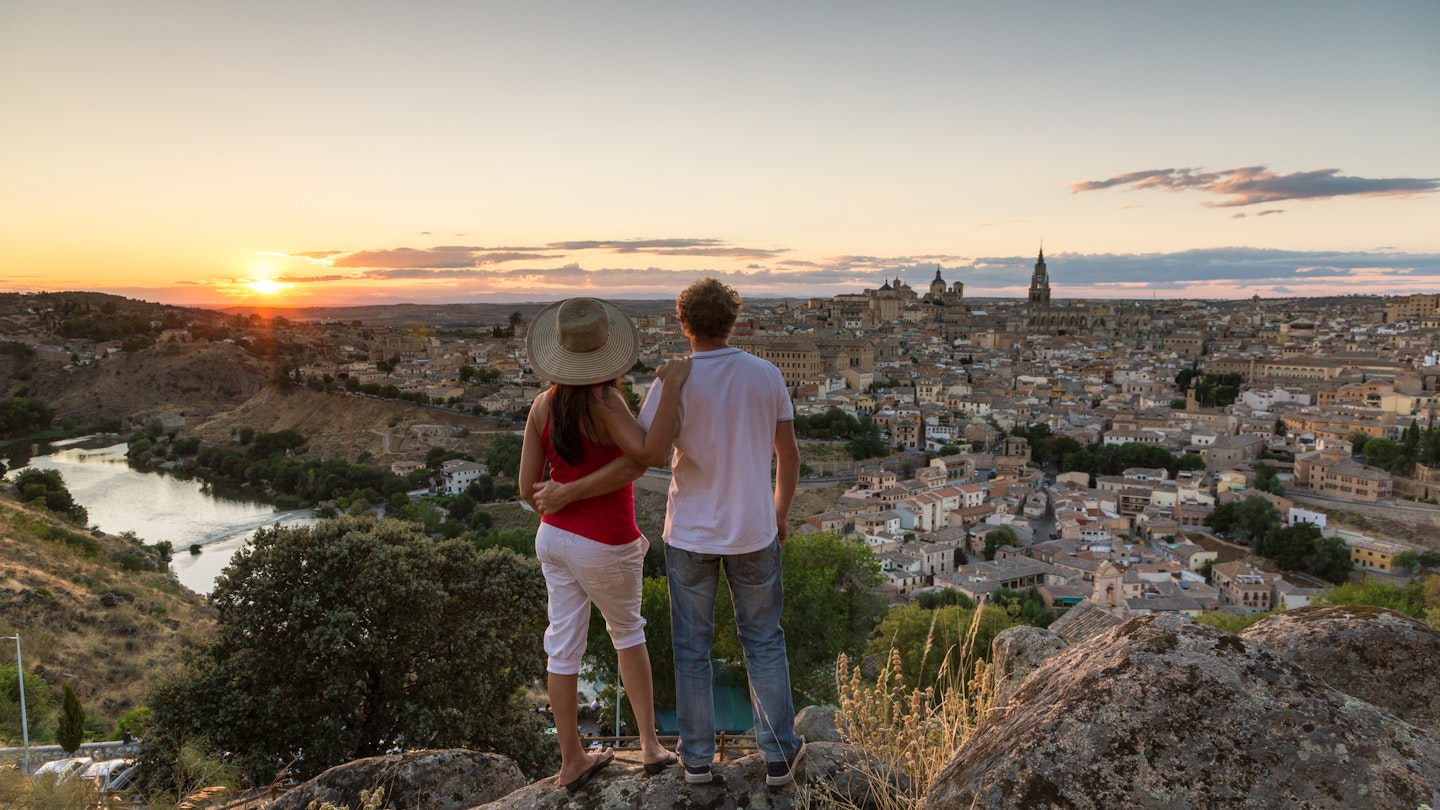
The vibrant city of Madrid is overflowing with artistic and culinary treasures, not to mention an irresistible energy of its own – we’d recommend a minimum of three days to immerse yourself in its charms.
The capital of Spain also serves as a gateway to some of the most beautiful towns and attractions anywhere in the country. There are walled cities, Roman ruins, intimate Spanish villages, and even a Unesco World Heritage-listed palace-monastery complex, all no more than an hour away. Here’s our pick of the best days out from Madrid.
Explore the planet’s most surprising adventures with our weekly newsletter delivered to your inbox.
1. Explore the historic streets of Toledo
Travel time: 1 hour by car or just 30 minutes by train
The walled city of Toledo is one of the most popular day-trip destinations from Madrid. Rich in Arab, Jewish and Christian history, the former Spanish capital is a Unesco World Heritage Site. Getting lost in Toledo’s tightly-knotted streets is the best way to explore it, particularly the narrow alleys around Plaza Santa Clara. But if you want a more focused itinerary, following the artwork of El Greco will bring you to some of the city’s most spectacular sites.
Head to the medieval Catedral de Toledo to see El Greco’s The Disrobing of Christ before venturing to the Museo del Greco, the only museum in Spain dedicated to the artist. The trail also leads to the Museo de Santa Cruz, where you’ll see his Sagrada Familia con Santa Ana alongside a vast collection of decorative art and ceramics. For another taste of Toledo, visit Museo Sefardí in the 14th-century Sinagoga del Tránsito to learn about the history of Jewish culture in Spain, or get an insight into Toledo’s Arab past at the Mezquita del Cristo de la Luz, which dates back to around 1000 CE.
How to get to Toledo from Madrid: If driving, take the A-42 south. Alternatively, take a train from Madrid’s Atocha station. The journey takes about an hour by car and a little over 30 minutes by high-speed train.
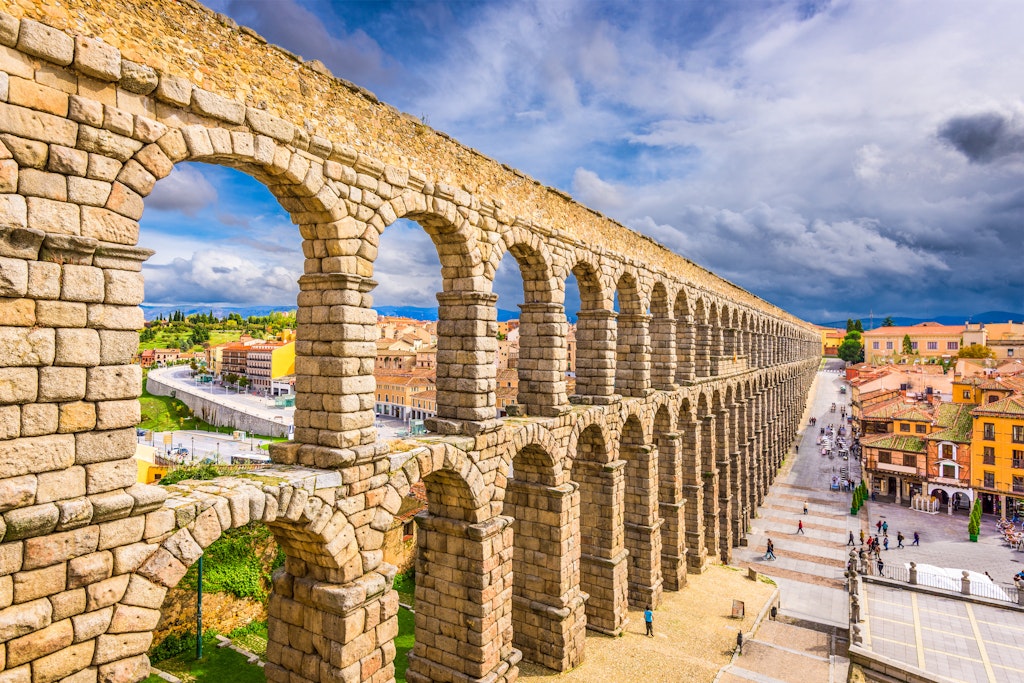
2. See an impressive Roman aqueduct in Segovia
Travel time: 30 minutes
Here in Segovia, one of Spain’s single most impressive Roman monuments, El Acueducto rises over the eastern entrance to the old city. From there, busy traffic-free streets climb past Romanesque churches and pretty squares to the city’s summit and the Plaza Mayor, the heartbeat of the city that’s watched over by a 16th-century Gothic cathedral – one of the country’s finest and most formidable structures.
Continuing down the cobbled streets to the west takes you to El Alcázar, a castle said to have inspired Walt Disney’s design for Sleeping Beauty’s castle. The views from the gardens take in rolling hillsides and sandstone churches all across the Castilian countryside.
How to get to Segovia from Madrid: High-speed trains run hourly between Madrid’s Chamartin station and Segovia, taking less than half an hour.
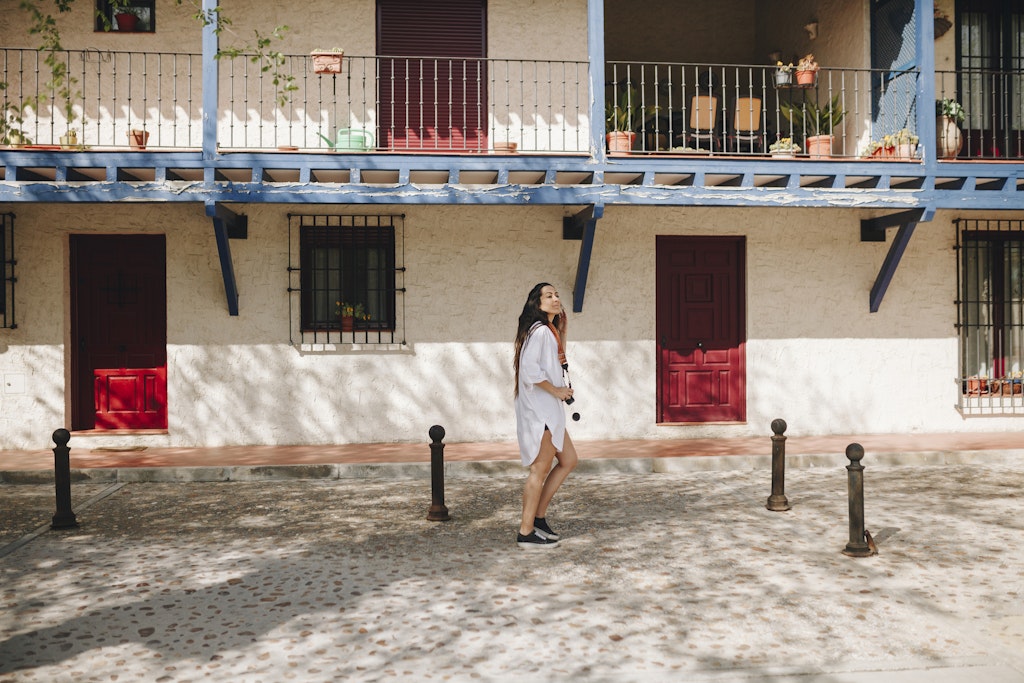
3. Join a fiesta in rustic Chinchón
Travel time: 50 minutes
The prettiest of all the villages within striking distance of the Spanish capital, Chinchón has at its heart an enchanted, rough-hewn town square. All roads in Chinchón lead to the rustic Plaza Mayor, a gloriously ramshackle example of Spain’s traditional village squares. Encircled by sagging balconies on wooden buildings stories high, it’s the scene for the town’s biggest fiestas and even an Easter passion play during Semana Santa (Holy Week).
How to get to Chinchón from Madrid: Chinchón is 45km (28 miles) southeast of Madrid. Take the N-IV motorway and exit onto the M404, or catch a bus from Madrid’s Avenida del Mediterráneo, 100m (328ft) east of Plaza del Conde de Casal. It takes about 50 minutes.
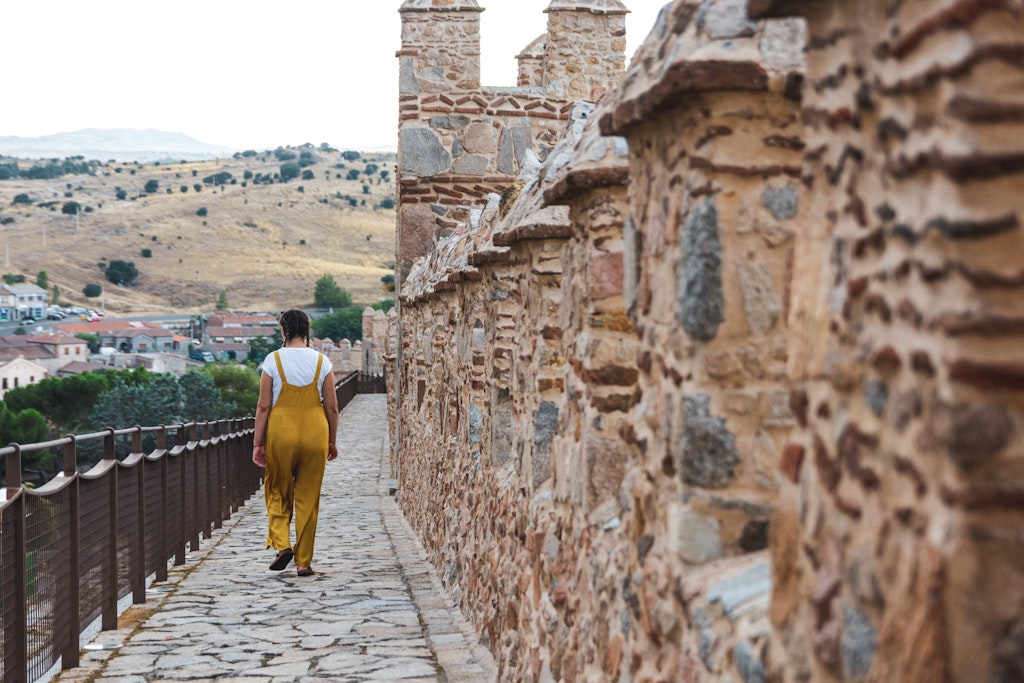
4. Walk the medieval walls surrounding Ávila
Travel time: 1 hour
Encircled by near-perfect city walls, Ávila is beautiful from afar and one of Spain’s more intimate urban experiences once you pass through its gates. Dating back to the 12th century, the city’s Murallas run for 2.5km (1.5 miles) with eight arched gateways, 88 watchtowers and more than 2500 turrets. You can climb the walls in places and walk along nearly 1.6km (1 mile) of their length.
From outside, the best views are from Los Cuatro Postes. Almost an extension of the city walls, the Catedral del Salvador is another extraordinary house of worship, as impressive in scale as it is exquisite in its detail. And of the many churches inside the walls, the Convento de Santa Teresa is the most storied, a pilgrimage site of great spiritual significance to Catholics everywhere.
How to get to Ávila from Madrid: Trains connect Ávila with Madrid’s Chamartin station in just over an hour.
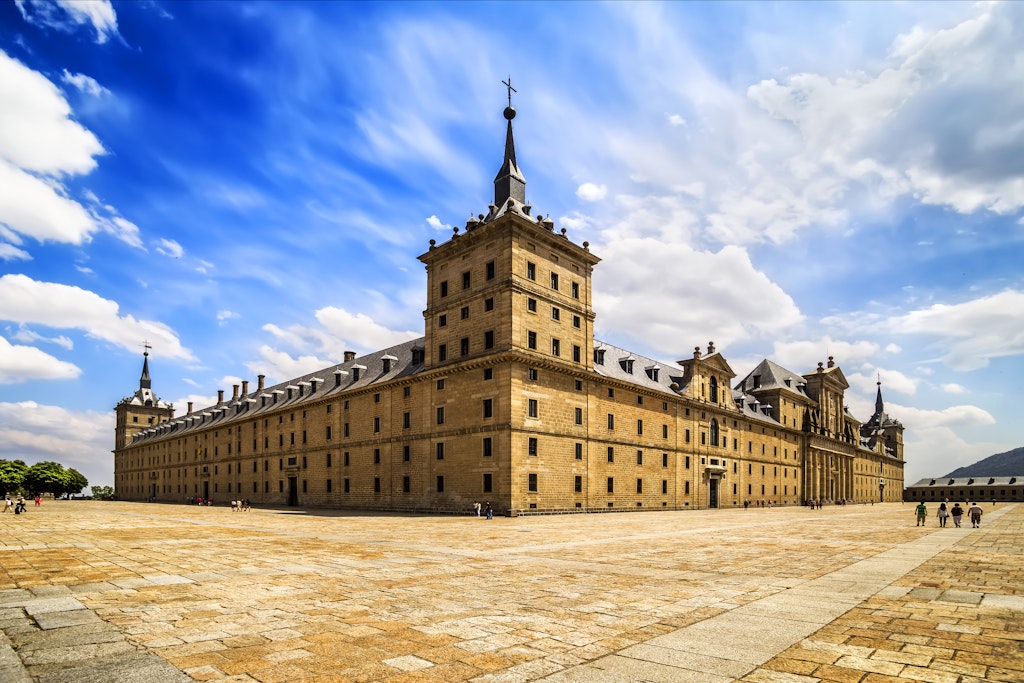
5. Marvel at the artworks at San Lorenzo de El Escorial
Travel time: 1 hour
In San Lorenzo de El Escorial, one of Spain’s grandest royal monuments rises from the foothills of the Sierra de Guadarrama northwest of Madrid with vast royal gardens and astonishing artworks within. The Real Monasterio de San Lorenzo de El Escorial is an extraordinary place, a vast yet supremely elegant palace-monastery filled with artworks by artists such as El Greco, Titian, Tintoretto, José de Ribera and Hieronymus Bosch; the 1576 white marble statue of a crucified Christ by Benvenuto Cellini is a sublime high point.
Just outside, the Jardín de los Frailes is a classic example of royal, monumental gardens, and within it lies the neo-classical, 18th-century Casita del Príncipe, a stunning little counterpoint to the sheer grandeur all around it.
How to get to San Lorenzo de El Escorial from Madrid: Renfe C8 cercanías (local trains) depart for El Escorial from Madrid’s Atocha or Chamartín train stations. Or catch a bus from platform 30 at Madrid’s Intercambiador de Autobuses de Moncloa. The journey takes about an hour.
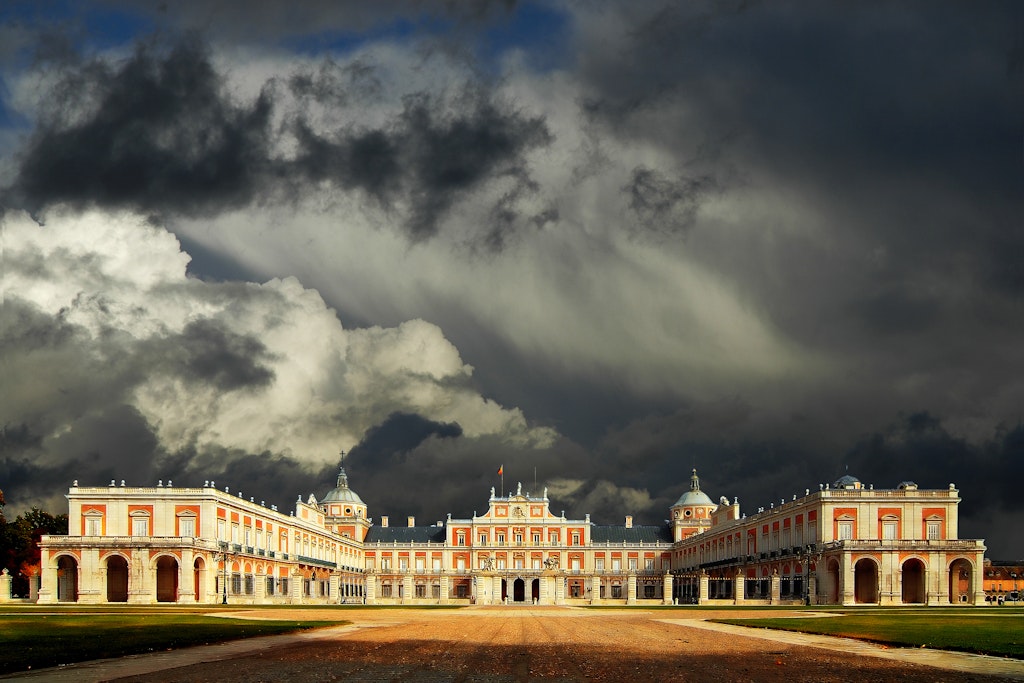
6. Be awed by the royal palace of Aranjuez
Travel time: 45 minutes
A royal palace and gardens in a classic (and always buzzing) Spanish provincial town – what’s not to like about Aranjuez? Far grander than any of the palaces that Madrid itself has to offer, Aranjuez’s Palacio Real was a favored pleasure retreat for Spanish royals down through the centuries, and it shows. The 300-room palace was modeled on France’s Versailles and is surrounded by expansive and perfectly manicured gardens. Museums on the grounds showcase everything from royal finery in the Casa del Labrador to the pleasure boats beloved by royals with way too much time on their hands in the Museo de Falúas.
How to get to Aranjuez: If driving, take the N-IV south, then follow the signs to the town along the M-305. Otherwise, C3 cercanías trains leave every 15 or 20 minutes for Aranjuez from Madrid’s Atocha station. The journey takes about 45 minutes.
This article was first published December 2020 and updated June 2023
Let Elsewhere plan your next trip

Meet Elsewhere, Lonely Planet’s new travel-planning service. From Argentina to Vietnam, our worldwide network of local experts can plan your trip from arrival to departure, so you can spend less time poring over train timetables and more having the best experiences possible.
Let Elsewhere plan your next trip

Meet Elsewhere, Lonely Planet’s new travel-planning service. From Argentina to Vietnam, our worldwide network of local experts can plan your trip from arrival to departure, so you can spend less time poring over train timetables and more having the best experiences possible.


Jun 30, 2023 • 8 min read
Explore Spain’s unique cultural heritage and savor its delectable cuisine with these incredible road trip routes.

